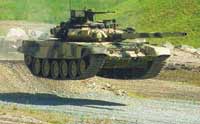Russia to develop new generation of tanks by 2020
Russia’s armored troops will consist of T90 tanks and tanks of the new type by 2020.

The Director of the Federal Service of the Russian Defense Order, Sergei Mayev, did not disclose the name of the new armored machines, but unveiled some of their constructive differences.
“The new tank will have better fire and range capabilities and a higher weapon yield. In addition, it will be outfitted with 7-kilometer range missiles,” the official said.
An average Russian tank develops the speed of 30-50 km/h, whereas the tank of the new generation will be able to travel at the speed of 50-60 km/h. To crown it all, the crew of the new tank will be able to conduct battle actions for 24 hours without leaving the machine.
It is worthy of note that there is only one enterprise left in Russia which deals with the production of tanks.
T-90 is a Russian main battle tank derived from the T-72, and is currently the most modern tank in the Russian Ground Forces and Indian Army arsenal. The successor to T-72BM, the T-90 uses the gun and 1G46 gunner sights from T-80U, a new engine, and thermal sights. Protective measures include Kontakt-5 ERA, laser warning receivers, the EMT-7 electromagnetic pulse creator for the destruction of magnetic mines and the Shtora infrared ATGM jamming system.
The T-90S version is in service with the Indian Army, and the local production of T-90S Bhishma tanks started in India in 2006 or 2007. Bhishma (also spelt as Bishma) is a warrior from the Indian epic, the Mahabharata. In 2001, India bought 310 T-90S tanks from Russia, of which 120 were delivered complete, 90 in semi-knocked down kits, and 100 in completely-knocked down kits. T-90S were made by Uralvagonzavod and the uprated 1,000-hp engines were delivered by Chelyabinsk Tractor Plant. These tanks however did not feature Shtora active protection system though there are reports that a separate contract for shipment of a modernized version of this suite is being discussed. The T-90 was selected because it is a direct development of the T-72 which India already employs, simplifying training and maintenance. India bought the T-90 after the delay in production of the domestically developed Arjun main battle tank, and to counter Pakistani deployment of the Ukrainian T-80UD in 1995–97.
The deal between India and Russia, estimated at a value of USD $750 million, also included the complete transfer of T-90 technology and weapon systems to India. With Russian and French assistance, India developed an improved version of T-90S, known as the Bhishma. However, India has reported that problems have arisen with the French-designed thermal sights used on the T-90 due to intense desert heat. In 2006, the Indian Government awarded the Ordnance Factory Board a USD $2.5 billion deal to manufacture 1,000 T-90 Bhishma tanks for the Indian army. On October 26, 2006, India signed another deal with Russia for 800 million USD for 330 T-90S tanks.
The T-90's main armament is the 2A46M 125 mm smoothbore gun. This is a highly modified version of the Sprut anti-tank gun, and is the same gun used as the main armament on the T-80-series tanks. It can be replaced without dismantling the inner turret and is capable of firing armour-piercing fin-stabilized discarding sabot (APFSDS), high-explosive anti-tank (HEAT-FS), and high explosive fragmentation (HE-FRAG) ammunition, as well as 9M119M Refleks anti-tank guided missiles. The Refleks missile has semi-automatic laser beam-riding guidance and a tandem hollow-charge HEAT warhead. It has an effective range of 100 m to 6 km, and takes 17.5 seconds to reach maximum range. Refleks can penetrate ~950 mm of steel armour and can also engage low-flying air targets such as helicopters.
Subscribe to Pravda.Ru Telegram channel, Facebook, RSS!


